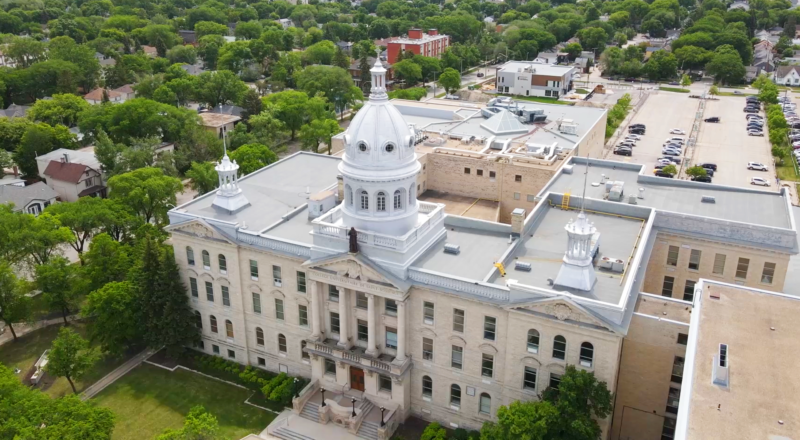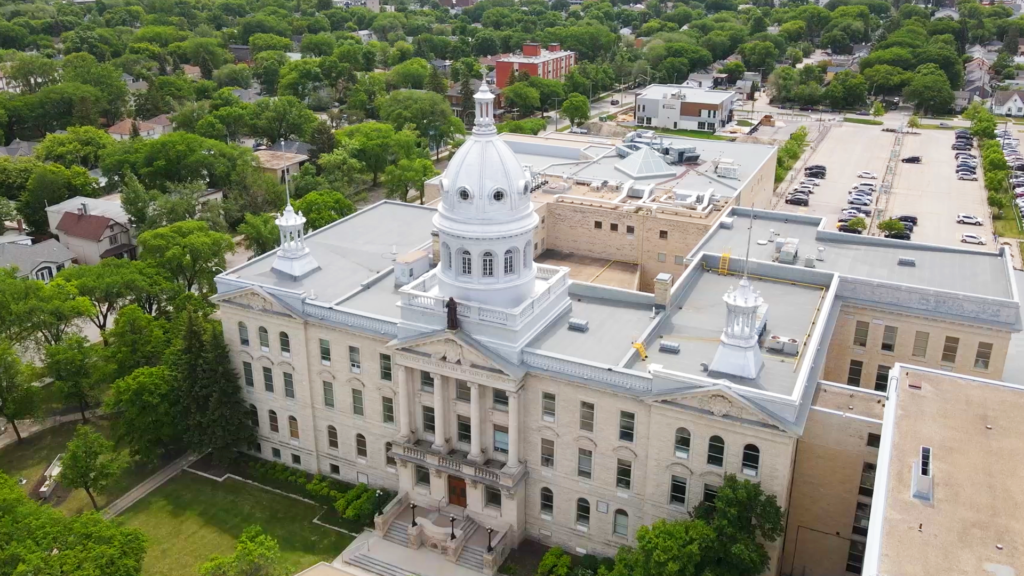
/ Blog
June 21, 2022
An Institute of French Excellence: Université de Saint-Boniface
With over 200 years of excellence in French education to build on, the Université de Saint-Boniface has risen from extremely modest beginnings to welcoming students from around to the world to an exceptional academic experience! While some of the buildings used by the institute did not stand the test of time, it’s final building, Le Petit Séminaire, has become a landmark in the community after its construction over 100 years ago. The towering facade, complete with classical columns and a magnificent cupola, is unmistakable in the community of St. Boniface. Originally built for religious studies, it is a fitting representation of the connection between religion and education that was once integral to the culture of Manitoba’s francophone community. Today, the Université de Saint-Boniface is a secular institution, but it remains at the heart of French life in the community, with its historic building gracefully adapting and expanding to accommodate an ever-growing body of students, arriving to continue the tradition of celebrating all things French along the banks of the Red River.
The roots of the Université de Saint-Boniface we know today can be traced back to 1818. Joseph Norbert Provencher, a priest at the time that would later become a bishop, had just arrived in Red River that year, and was sent to open a mission known as St. Boniface. In addition to evangelizing to the local community, Provencher also set up a school of sorts, located in a simple, unassuming wooden structure with four windows and a door. Measuring just 18 x 15 feet, the building also served as a chapel and Provencher’s residence. The goal of the school was to educate the sons of the French-speaking community in Latin and religion, hoping that they would eventually become priests. With Provencher often traveling for his work and a very small number of students (only two to begin with), classes were held in an irregular fashion. Starting in 1837, some secular priests helped out with teaching, and when the Grey Nuns arrived in 1844, they also took on the role of educators.
The humble school officially became Collège de Saint-Boniface in 1855, a year after Alexandre-Antonin Taché became the Bishop of St. Boniface. Taché was a champion of French language and culture, and so erected a new school building for the French community at the corner of Taché Avenue and Masson Street in St. Boniface. A vast improvement from the first building, the new Georgian-style structure was two storeys tall, measuring at 60 x 34 feet, included a two-storey entrance, and was crowned with a small cupola. It was just as this new building was being constructed that one particular young man, destined for greatness, began his education at the school. From 1854 to 1858 Louis Riel attended Collège de Saint-Boniface. Riel would go on to become a mythical figure, Métis leader and founder of the Province of Manitoba, hanged for treason in 1885.
In 1871, a year after Riel successfully lead Manitoba to become a province, Collège de Saint-Boniface was incorporated, becoming the first official college-level educational institute in Western Canada. Taché believed this would ensure the school would have authority over what was taught and in what language, which for Taché meant French. As Taché had hoped, the school would become the heart of the French community, drawing people together for all kinds of events that celebrated the French culture and the promoted the French language.
In 1877, the Collège de Saint-Boniface joined forces with St. John’s College and Manitoba College to form the University of Manitoba. The federation of colleges represented three different churches, the Roman Catholic, Anglican, and Presbyterian, respectively. While the University dictated the requirements for completing a degree, the colleges provided the necessary classes. Despite this union, the Collège maintained full autonomy as a Catholic college, eventually becoming a faculty within the University.
Following the arrival of French-speaking immigrants from Quebec and Europe, and along with being the only Catholic college in the province, enrollment at Collège de Saint-Boniface was growing. Serving both the French and English communities and by 1880 a larger school building was required for its 300 students. This time Taché employed the prolific English architect Balston C. Kenway, who designed a Second Empire style building on Provencher Boulevard, about where Provencher Park is located today. The three and a half storey stone building with a mansard roof and crowning cupola was later transformed by several large additions into an imposing institution. Towers and parapet walls were trimmed with a dentil cornice and supported multiple spires reaching for the sky, while the signature cupola was enlarged to tower over a grand entrance. When all the architectural elements were put together, the final iteration of the building gave the impression of being a castle, the seat of French culture and language in Manitoba.
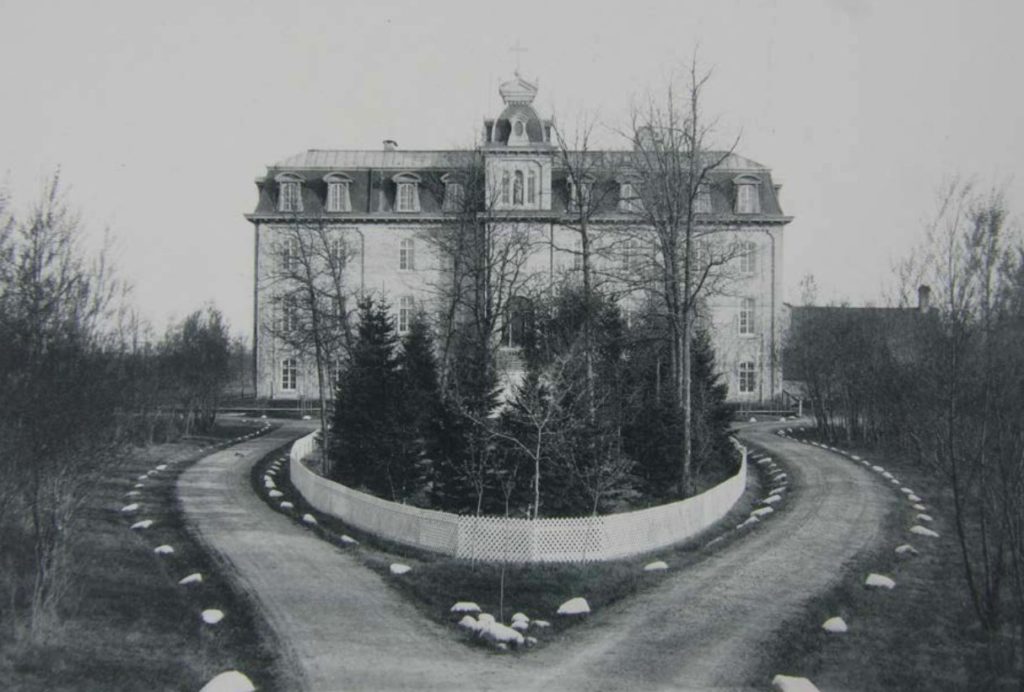
The second Collège de Saint-Boniface building, constructed on Provencher Boulevard, circa 1900.
Source: Archives of Manitoba in the City of Winnipeg Report
At the same Collège de Saint-Boniface was gaining momentum, and the french language was falling out of favour in Manitoba. In 1971 when the Collège was incorporated, about 50% of the province’s population was francophone. By 1891, only 6.7% of Manitoba was French-speaking, with most of this population residing in St. Boniface. This decline was further exasperated by the Manitoba Schools Questions, the battle for the right for both the French language and religious education in Manitoba’s public schools around the turn of the century. For the French community, language and religion were indivisibly joined, the cornerstone of their identity. With religion being banned from public schools in 1890, the Catholic francophone community was forced to send their children to private schools that were often a struggle to afford. Being a private institution, the Collège de Saint-Boniface was not directly impacted by this legislation but saw its enrollment decline as children from the public school system no longer had the educational background to prepare them for the Collège. Taché, the driving force behind the Collège, was on the front lines of the fight for the French identity, waging a six-year battle for religion to be allowed in public schools. In 1896 the crisis seemed to have passed, with both religion and minority languages, such as French, being allowed in public schools in limited applications. But by 1916 trouble was brewing once again, with every language except English being banned in public schools and all new teachers exclusively receiving training in English. The private Collège continued to offer French education, along with encouraging public schools to deify the new legislation. The “French resistance” remained strong throughout the first half of the 20th century, allowing the language to survive until it was gradually reintroduced into public schools starting in 1947.

The second Collège de Saint-Boniface building, after large additions, was almost unrecognizable when compared to its original form.
Source: PastForward
While Collège de Saint-Boniface was a stronghold for French language and culture throughout the tumultuous Manitoba Schools Questions era, its building did not prove to be as resilient. On November 24th and 25th, 1922, a tragic fire swept through the building. Even worse than the destruction of the structure and the 20,000-volume library, was the loss of one teacher and nine students to the flames which devastated the community. Despite many records indicating the Collège was completely lost to the fire, a small building at 607 Langevin Street begs to differ. Peaking over the flat roof of the more modern front of the building is a mansard roof, suggesting the old Collège de Saint-Boniface lives on. Once used by CBC Radio-Canada, the “historic building” was deemed too large and put up for rent in March 2016.
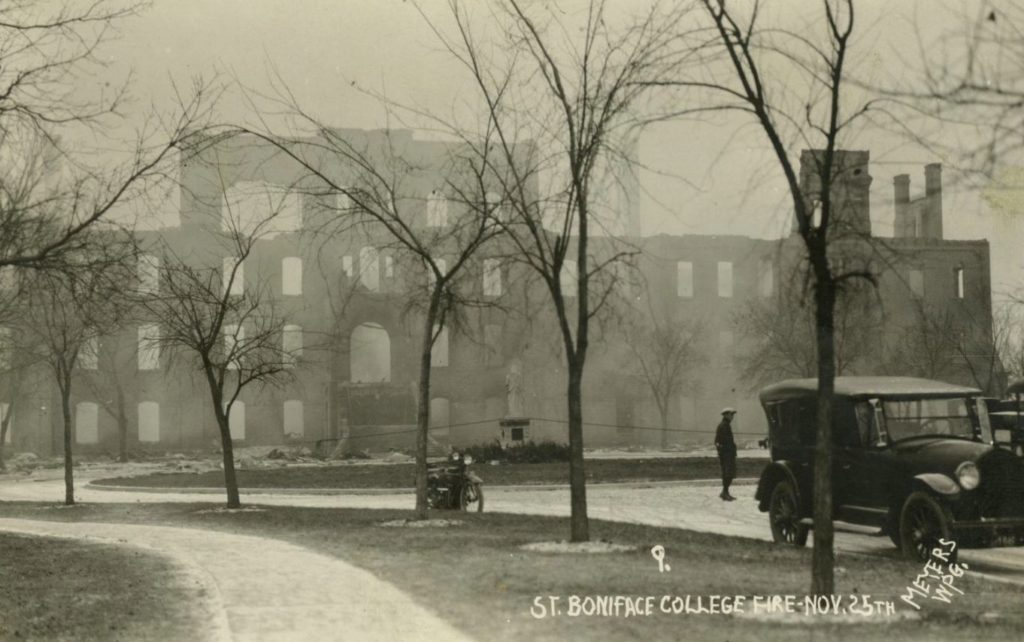
The Collège de Saint-Boniface on Provencher Boulevard burned to the ground on November 24th and 25th, 1922, with ten people losing their lives in the tragic fire.
Source: PastForward
After the fire, and already operating three private schools, the Archdiocese of St. Boniface could not afford to rebuild Collège de Saint-Boniface. Arthur Béliveau, the Archbishop of St. Boniface, came to the rescue and donated an existing building, Le Petit Séminaire de Saint-Boniface at 200 De la Cathédrale Avenue, to be the new site of the Collège. Le Petit Séminaire, the Minor Seminary, was founded by Archbishop Adélard Langevin in 1909 as a school of theology for priests in training. Designed by Montréal architect Joseph-Ovide Turgeon, work began on the building on May 18th, 1911. The Classical Revival style building seems to be Turgeon’s only project in Manitoba, while the contractor, the local firm of Joseph H. Tremblay & Company, was involved with many Winnipeg builds. Construction of Le Petit Séminaire took longer than expected as there were two costly fires in the central portion of the building while the building was in progress. Despite these delays, seminary students started classes in the building in September of 1912, with the chapel being completed the next spring in time for Easter.
Costing about $225,000 to build, Le Petit Séminaire was an elegant three-storey building complete with a kitchen, ice house, chapel, and dormitory. The view of the building was dominated by the large metal-clad central cupola suspended over 40 meters above the ground. Its scale overshadowed the front facade, clad in limestone and featuring a grand central staircase, with Doric Order columns rising above to support an entablature proclaiming “COLLÈGE UNIVERSITAIRE DE SAINT-BONIFACE”. Above the entablature was a dentilled pediment with carved figures and the entire ensemble was capped with a statue of “curé d’Ars”, the patron saint of secular priests. After Le Petit Séminaire became home to Collège de Saint-Boniface in 1922, changes slowly began to take place. Starting in 1924, the building saw the first of eight major additions, with the most recent opening in 2011. Gymnasiums, a one-lane bowling alley, library, theatre, sports centre, student centre, science pavilion, and more were added to serve the growing number of students. After nearly 100 years of additions and renovations, while most of the original exterior finishes persist, almost nothing from the original building remains inside except some finishes in the chapel and in the third-floor classroom. On February 4th, 2019, the building was added to the City of Winnipeg’s List of Historical Resources, protecting its character-defining elements from alteration and the building from demolition.
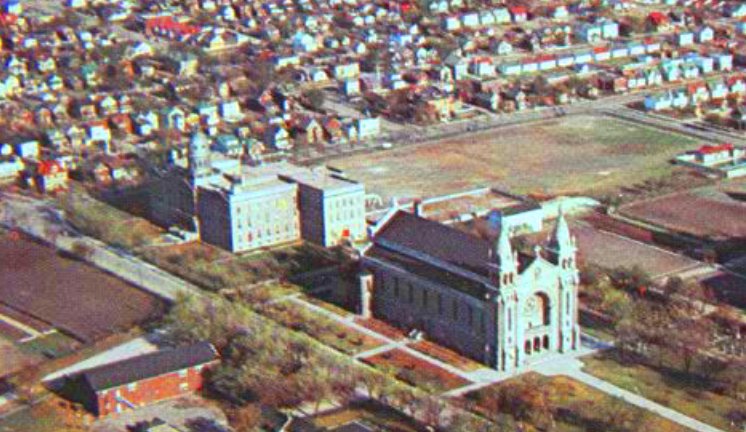
Looking southeast from the Red River, Le Petit Séminaire is located behind the St. Boniface Cathedral. This aerial photo, circa 1950, shows the Cathedral before it burned down in 1968. Today only the facade of the Cathedral remains.
Source: Archives of Manitoba in the City of Winnipeg Report
Just as the Le Petit Séminaire building has adapted to accommodate a changing community, so too has the institution that uses it. The Catholic, English-speaking St. Paul’s College was founded in 1925, allowing Collège de Saint-Boniface to begin phasing out its English programming, which ended in 1941. Women were finally allowed to attend school in 1959, and continuing education classes started in 1969. The same year the Collège was taken over by a secular administration, as old programs were closed and new degrees were offered. Finally, in 2011, the Université de Saint-Boniface as we know it today was created, and granted full university status by the province, although it retained its ties with the University of Manitoba. Over 10,00 students from 24 countries attend the school, choosing from 16 programs of study.
After officially becoming the Université de Saint-Boniface, the school has had plenty to celebrate. In 2018 it marked 200 years of French language education in Manitoba. Then they won the Institutional Conservation Award of Excellence at Heritage Winnipeg’s 36th Annual Preservation Awards in 2022 for conservation work completed with the front entrance doors. The Award recognizes the people and projects that go above and beyond in the conservation of Winnipeg’s built heritage. The Université de Saint-Boniface’s efforts included the commissioning of replica front doors by Yarrow & Sash, to replace the original doors that were taken off the building in 1975. Installed in 2021, the new doors add warmth and authenticity to the grand front entrance. The Université de Saint-Boniface also participated in Doors Open Winnipeg 2022, inviting guests behind closed doors to visit the splendid cupola. With rave reviews for both the outstanding architecture and engaging tours, the Université de Saint-Boniface won “Best Tour” in the prestigious Doors Open Winnipeg 12th Annual People’s Choice Awards.
Today the Université de Saint-Boniface is a symbol of resilience, both of the French community in Manitoba and of built heritage. In conserving the building the history of the community is also preserved, telling a story of overcoming obstacles to eventually grow and flourish. It celebrates the best of francophone culture and Classical Revival architecture, all while providing a scene of place for all who call St. Boniface home. Adapted and re-imagined over the past 100 years, it is an excellent example of how a historic building can change to serve a modern community, all while maintaining its historic integrity. As French-language education continues to grow in popularity in Manitoba, the Université de Saint-Boniface is on firm footing, ready to serve its community for another 200 years or more!
THANK YOU TO THE SPONSOR OF THIS BLOG POST:

Written by Heritage Winnipeg.
SOURCES:
200 Years of French Education at Université de Saint-Boniface | Université de Saint-Boniface
1910 - Collège université de Saint-Boniface, Winnipeg, Manitoba | Archiseek
Architectural Styles | Heritage Manitoba
Brief History | Université de Saint-Boniface
Kenway, Balston Cooper | Biographical Dictionary of Architects in Canada 1800-1950
List of Historical Resources | City of Winnipeg
Manitoba Schools Question | The Canadian Encyclopedia - March 29, 2018
Petit Séminaire de Saint-Boniface | MAIN – Manitoba Archival Information Network
PROVENCHER, JOSEPH-NORBERT | Dictionary of Canadian Biography
Radio-Canada cherche des locataires pour son édifice à St-Boniface | Radio-Canada - March 1, 2016
RIEL, LOUIS | Dictionary of Canadian Biography
St. Boniface College Fire - Nov. 25th | PastForward
Université de Saint-Boniface | BaladoDécouverte





